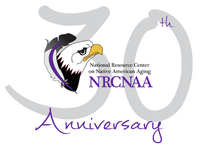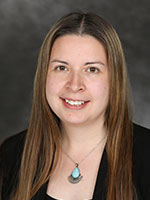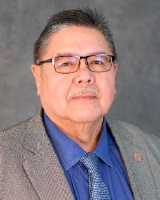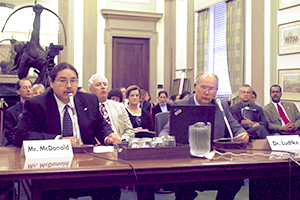Thirty Years of Changing the Lives of Native Elders
By Jena Pierce on
 How can data help put food on the tables of Native
Elders? This was one of many the questions that officials
at the National
Resource Center on Native American Aging (NRCNAA)
asked 30 years ago when their organization was created:
how can they find a way to gather data on Elders in
Indigenous communities to meet Title VI requirements
– and meet Elders' needs?
How can data help put food on the tables of Native
Elders? This was one of many the questions that officials
at the National
Resource Center on Native American Aging (NRCNAA)
asked 30 years ago when their organization was created:
how can they find a way to gather data on Elders in
Indigenous communities to meet Title VI requirements
– and meet Elders' needs?
According to the Administration for Community Living (ACL), the federal funder of NRCNAA, "In 1978, the Older Americans Act was amended to include Title VI, which established programs for the provision of nutrition and supportive services for Native Americans (American Indians, Alaska Natives, and Native Hawaiians)."

Dr. Collette Adamsen is the director of NRCNAA at the Center for Rural Health (CRH) within the School of Medicine & Health Sciences (SMHS) at the University of North Dakota (UND). She is also an associate director of CRH, and a research assistant professor at SMHS. "The goal over the past 30 years, with everything NRCNAA has done, has really been to improve the overall health for our Native Elders and connect them with more services to allow them to live more healthier and happier lives."
The goal over the past 30 years...has really been to improve the overall health for our Native Elders and connect them with more services to allow them to live more healthier and happier lives.
Adamsen started as a NRCNAA project coordinator and rose through the program to become director in 2017. "When we do the needs assessment surveys, we are working with the communities in a partnership. They are essentially becoming the researchers – they collect the data and they administer the survey to their tribal Elders. This is a true partnership in research and data collection."
Humble Beginnings
Adamsen explained that there was not specific funding for Elders in tribal communities until Title VI was added. The barriers for tribes to receive needed funding was hard to overcome. NRCNAA was instrumental in helping tribes meet the requirements to receive the funding for the Elders through a needs assessment survey.

Julie Arnold, CRH web and graphic team leader, worked with NRCNAA since it's very beginning in 1994. "There was great excitement about helping the communities we worked with. There wasn't another project like this."
Arnold is still connected to this day, as she created and maintains the NRCNAA website and is currently working on the new Resource Center on Native Aging and Disability website. But in those early days, everything was done by hand.
"NRCNAA started a small survey meant to be, at most, regional for tribes," Adamsen shared. "But ACL asked if the program could offer the survey nationally so needs of Native Elders could be identified across the nation, for Title VI programs. There wasn't data on Native Elders back then and they didn't know what to expect."

McDonald
Dr. Leander "Russ" McDonald, current president of United Tribes Technical College, came to UND as a McNair Postbaccalaureate Scholar and had Dr. Richard Ludtke as his advisor. Ludtke was the research director at NRCNAA and introduced McDonald to the world of research. McDonald spent much of his time at the Chester Fritz Library, identifying surveys that would have questions regarding Native Elders.
McDonald would later become director of NRCNAA from 2007-2009.
"I would find surveys, meet with Dr. Ludtke on a weekly or bi-weekly basis over that summer, and we would determine what questions were a best fit for the population we were serving," McDonald said. "That fall, we did a pilot test on the Spirit Lake Reservation, where I grew up, at an Elder's gathering. We refined the survey based on that response and then offered the survey to Elder programs who were required to conduct a needs assessment to fulfill their grant requirements for Title VI funding. We were coming along fine and thought we were doing well with 27 sites, then the ACL's Administration on Aging (AoA) endorsed us, and things really took off."
With the AoA/ACL endorsement, the Identifying Our Needs: A Survey of Elders needs assessment survey was born.
Necessity of Data
McDonald remembers the importance of the early surveys. "The tribes were able to document disparities because of the survey, then we provided training on how to develop action plans based on those disparities," he said. "I was new to the research world, but this is when I realized the importance of data for guiding decision-making and funding sources to address the identified needs."
Currently, NRCNAA works with over 200 Title VI programs, representing over 250 Indigenous communities, which includes 21,095 tribal Elder responses from the most recent Cycle 8 survey.
People who help drive policy and allocations of funding want numbers – evidence there is a need for change – and without that data, it is out-of-sight and out-of-mind.
"There was a real need to gather accurate data," said Adamsen, "for populations that didn't have any data previously collected. People who help drive policy and allocations of funding want numbers – evidence there is a need for change – and without that data, it is out-of-sight and out-of-mind."
The predecessors of the resource center were way ahead of their time in working with tribal communities, doing respectful research, and utilizing that data and research to benefit the communities. One important factor has been building trust with the tribes. The data collected belongs to the tribes, and tribe-specific data is not shared with others. Their sovereignty is respected.
Best Data in the Nation
While the tribes own the data specific to their communities, national datasets have been created to allow comparisons between each tribes' disparities.

Senate Committee on Indian Affairs, on
Long-term Care and Health Needs of
America's Native American Elders on
July 10, 2002.
According to McDonald, the data the needs assessment survey collects is the "best data in the nation. There is no other dataset that has all the information that is offered through this ongoing study. We have provided policy recommendations to the White House Conference on Aging, the Senate Committee on Indian Affairs, and other national conferences, and regional trainings, on this data."
Adamsen feels the reputation of the NRCNAA is what has sustained the program for 30 years, and has brought additional opportunities to UND.
People have wanted to work with us on other areas that have branched off of the work we have become known for.
"Because of the reputation of NRCNAA," she said, "a lot of these areas have expanded. NRCNAA has such a good standing, not only with our tribal communities, but with other stakeholders, including our funders and other partners that work with Native communities. People have wanted to work with us on other areas that have branched off of the work we have become known for."
Resource Center on Native Aging and Disability
Enter the Resource Center on Native Aging and Disability (RCNAD), a newly-funded resource center for Indigenous communities, helping to build long-term services and community supports for Elders and those living with disabilities.
"It is like a larger version of the Native Aging in Place Project (NAPP)," explained Adamsen. "It is so important for our Elders, and persons with disabilities in our communities, to be able to stay within their tribe, in their homes, because a lot of time our communities don't have these resources. We often don't have nursing homes or long-term care facilities, so the Elders are often transported to facilities far from their communities. It becomes difficult for their families or friends to travel that distance to visit with them."
This newly-funded program, through ACL, began about five years ago. The National Indian Council on Aging had been awarded the first grant, and in 2023, it was awarded to UND for a five-year cycle. RCNAD is being built from the ground up, from the new name, to a new website and new goals.
Similar to NAPP, RCNAD will assist with providing services for Elders to age in place at home and offer sustainability through Medicaid home and community-based services waivers with third party billing. This will help tribes across the country maintain the services and the people that provide them in the community for the Elders. The Native Elder Caregiver Curriculum (NECC) provides training to those caring for the Elders.
From its origin as a small data shop, the program has grown tremendously, not only in staff, but also in services and funding. From the Native Urban Elder Needs Assessment, NAPP, NECC, and RCNAD, all provide varied assistance to Indigenous communities, but never lose track of their shared purpose: identifying Native Elder health and social issues and assisting in community-based solutions to improve the quality of life and delivery of support services.
"The two Resource Centers are working side by side," explained Adamsen. "Some of the data NRCNAA collects is helping to guide us through our work with RCNAD to look at some of those needs and those areas for the Elders around long-term services and support home- and community-based services, so it helps us build a model that will help support those communities."
It is all connected, and it all began 30 years ago with the creation of NRCNAA, Adamsen shared: "A lot of the previous directors have shared they felt good about being a part of a program that literally helped put meals on the tables of our Elders throughout the nation."


 is the communications manager at the Center for Rural
Health at the University of North Dakota School of
Medicine & Health Sciences in Grand Forks.
is the communications manager at the Center for Rural
Health at the University of North Dakota School of
Medicine & Health Sciences in Grand Forks.



